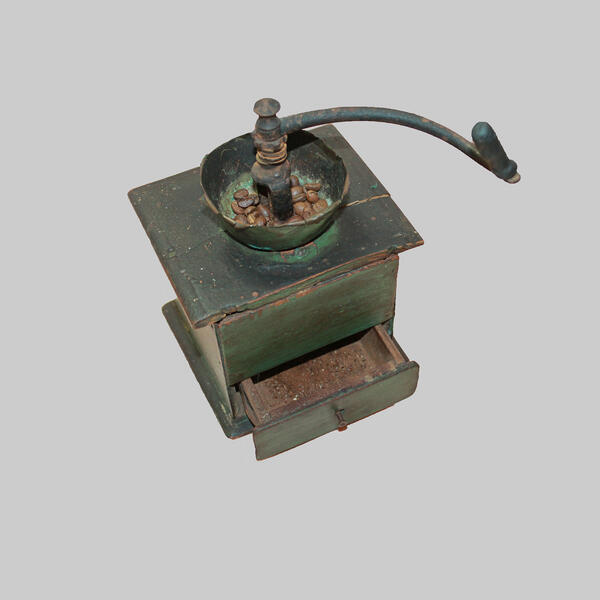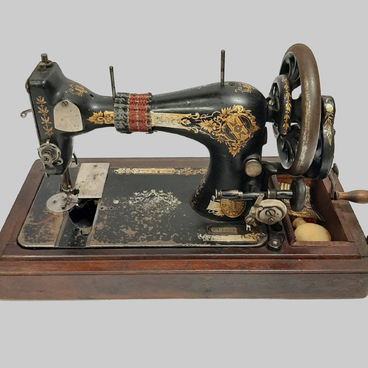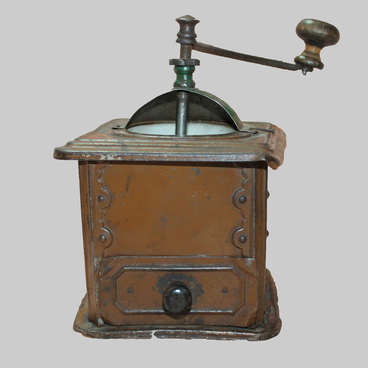The classic old coffee grinder consists of a wooden case in the shape of a cube and a drawer in which the ground coffee accumulated. The case has traces of self-staining in dark green. An open brass cup for pouring coffee is attached to the lid of the case. All elements of the coffee grinder are in working condition, with the exception of the grinding adjustment mechanism. It is rusted. The degree of preservation of the model suggests that most likely the coffee grinder was made in the late 19th century in Europe.
Initially, coffee beans were cooked whole without pre-grinding. For the first time, the Bedouin Arabs guessed to grind coffee and prepare a fragrant drink. They ground coffee beans in a mortar, which was a laborious process that required skill. Therefore, only men who had received special training were engaged in it. In the 15th century, the Arabs invented the first ever manual coffee grinder, which was a hollow cylinder with a handle. The cylinder was filled with grains, the handle was turned, and two millstones located inside crushed the beans.
In the middle of the 17th century, the first Turkish coffee grinders appeared. Similarly to their Arab predecessors, they had a cylindrical shape and were easy to hold in one hand by rotating the second removable handle. The handle also served as a spanner, with which it was possible to change the distance between the millstones and thereby adjust the size of the grain grinding. Such mills were designed, as a rule, for a small portion of coffee in 25-35 grams. European table-top manual coffee grinders, which appeared somewhat later than Turkish ones, are based on the same design. They usually have the shape of a cube. Ground grains are extracted from the coffee grinder by extending a special box on the side.
The European coffee grinder is inconvenient because its fixed part, i.e. a wooden box, is inconvenient to fix with one free hand. Thus, if you set up fine grinding on a European coffee grinder, it will be extremely inconvenient to grind coffee. A poorly fixed box will crawl on the table due to a large effort. Therefore, these coffee grinders are sometimes attached to fixed surfaces, such as walls or tables.
There was another type of coffee grinder, the so-called coffee grinder on wheels. Such models can be found among the exhibits of museums. They look almost like ancient chariots. In fact, these wheels are just the handles of a mill. ‘Wheeled’ coffee grinders were usually larger and roomier than their counterparts with a single handle. Such units could be both desktop and floor-based, i.e. those that are elevated and designed for large volumes of coffee.
Initially, coffee beans were cooked whole without pre-grinding. For the first time, the Bedouin Arabs guessed to grind coffee and prepare a fragrant drink. They ground coffee beans in a mortar, which was a laborious process that required skill. Therefore, only men who had received special training were engaged in it. In the 15th century, the Arabs invented the first ever manual coffee grinder, which was a hollow cylinder with a handle. The cylinder was filled with grains, the handle was turned, and two millstones located inside crushed the beans.
In the middle of the 17th century, the first Turkish coffee grinders appeared. Similarly to their Arab predecessors, they had a cylindrical shape and were easy to hold in one hand by rotating the second removable handle. The handle also served as a spanner, with which it was possible to change the distance between the millstones and thereby adjust the size of the grain grinding. Such mills were designed, as a rule, for a small portion of coffee in 25-35 grams. European table-top manual coffee grinders, which appeared somewhat later than Turkish ones, are based on the same design. They usually have the shape of a cube. Ground grains are extracted from the coffee grinder by extending a special box on the side.
The European coffee grinder is inconvenient because its fixed part, i.e. a wooden box, is inconvenient to fix with one free hand. Thus, if you set up fine grinding on a European coffee grinder, it will be extremely inconvenient to grind coffee. A poorly fixed box will crawl on the table due to a large effort. Therefore, these coffee grinders are sometimes attached to fixed surfaces, such as walls or tables.
There was another type of coffee grinder, the so-called coffee grinder on wheels. Such models can be found among the exhibits of museums. They look almost like ancient chariots. In fact, these wheels are just the handles of a mill. ‘Wheeled’ coffee grinders were usually larger and roomier than their counterparts with a single handle. Such units could be both desktop and floor-based, i.e. those that are elevated and designed for large volumes of coffee.



